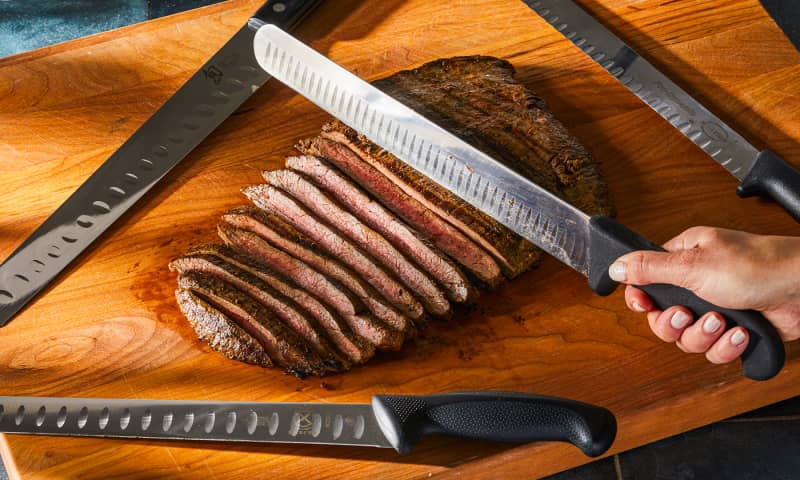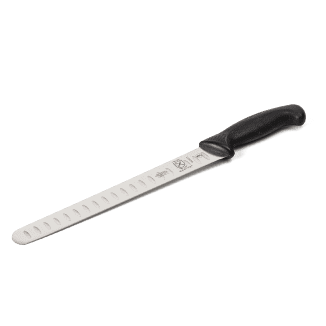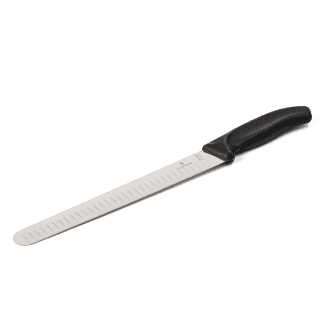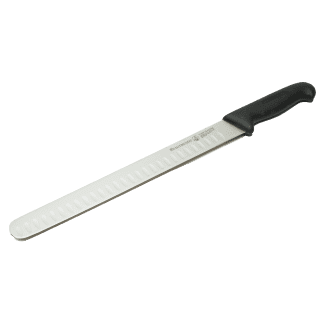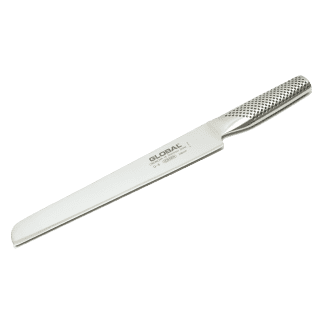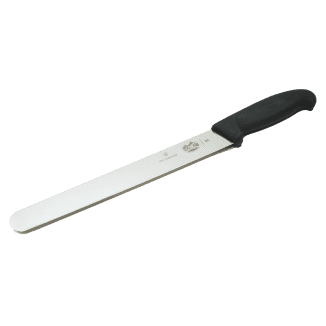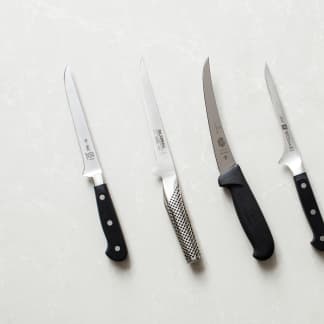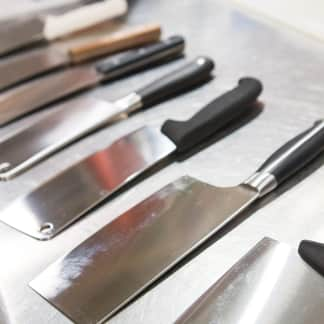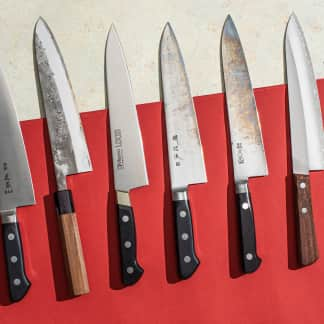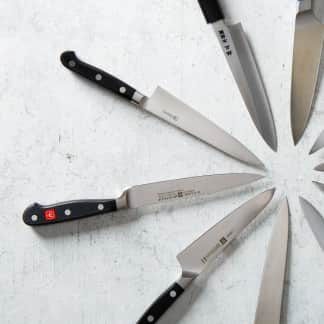The best slicing knives let you cut large pieces of meat and other foods easily. Our longtime favorite, the Victorinox Swiss Army Fibrox 12" Granton Edge Slicing/Carving Knife, has a long, ultrasharp blade that makes for effortless slicing. It also sports a well-cushioned plastic handle that’s easy for hands of all sizes to grip.

A good chef’s knife or gyuto can work perfectly well for slicing cuts of meat such as a pork loin or roast beef. But for slicing bigger boneless cuts and roasts such as roast turkey breasts, flank steak, or a brisket, a dedicated slicing knife is ideal. Slicing knives have relatively narrow blades measuring 10 to 12 inches in length—significantly longer than our favorite chef’s knives—so they’re better able to span larger pieces of food. And they have rounded tips that are less threatening and won’t accidentally jab holes in the food or any guests that might be hovering nearby as you work. (A handy feature if you’re carving a roast tableside, as many cooks like to do.)

What’s the difference between a slicing knife and a carving knife?
In the test kitchen, we vastly prefer a slicing knife to its more traditional equivalent, the carving knife. While there is some overlap between the categories, we generally distinguish between slicing and carving knives on the basis of their blade design. Carving knives have shorter, narrower blades measuring about 8 to 10 inches; they also have pointy tips. Slicing knives are longer (10 to 12 inches) and often a bit taller from edge to spine; they have blunt, rounded tips. In theory, the pointed tips on carving knives make them useful not only for slicing boneless meats but also for breaking down a roast chicken or turkey. But as N. Brian Huegel, knife expert and owner of Country Knives Inc., noted, their points are “virtually useless” since they’re at the end of blades that are still relatively long, making them hard to control for intricate tasks such as deboning.


The primary advantage of a slicing knife (left) is its long blade, which easily spans large cuts of meat such as this brisket so that you can make clean, even slices. The shorter blade of a chef’s knife (right) doesn’t quite extend as far across big foods.
Both our experts and the cooks in the test kitchen feel that these knives are relics of a bygone time, filling a role that’s more ceremonial than functional—serving big roasts tableside, as families and restaurants used to do. Josh Donald of Bernal Cutlery put this shift into perspective. “The big factor with the decline of carving knives in importance is the dramatic decrease in the importance of the Sunday dinner ritual,” likely in the ’60s or ’70s, he told us. With fewer families settling down to a Sunday roast, there was less demand for the dedicated knives typically used to carve those roasts. Huegel explained further that selling slicing knives separately is a relatively modern development; previously, carving knives were sold as part of a set with a carving fork. “As the popularity of these sets waned over the last 40 years and the interest in gourmet cooking expanded . . . cutlery manufacturers have promoted knives traditionally sold only to butchers and professional chefs, which include[d] a wide variety of carving/slicing knives.”

As part of this shift, cooks have come to prefer longer, more blunt-tipped slicing knives for slicing meats. There’s also a practical consideration at work here. Carving knives are fairly similar to the chef’s knife or boning knife we’d otherwise use to break down a whole roast turkey or slice a steak—they’re a little longer and a little narrower but otherwise don’t offer significant advantages over those other tools. Slicing knives, by contrast, can’t be used to carve roasts, but because they’re longer and can tackle big foods that chef’s knives can’t, we think a good one is a more useful addition to your cutlery collection.
What to Look For
- Long Blade: Blades measuring 12 inches in length were better at spanning bigger foods (brisket, flank steak) and making long, smooth cuts than blades of 10 or 11 inches.
- Relatively Tall Blades: We also liked blades that were relatively tall, with a height from edge to spine of about 1.5 inches. Taller blades were easier to keep flush against larger cuts of meat as we worked, allowing us to make straight, even slices. They also meant that our hands sat higher above the food, so our knuckles didn’t scrape the cutting board as we worked, as they did with blades that were narrower from spine to edge.


Taller blades (left) elevated our hands slightly higher above the cutting board, allowing us to slice foods comfortably. Shorter blades (right) made our knuckles scrape on the cutting board as we worked.
- Moderately Thin, Rigid Blade: We preferred blades that were fairly slender from spine to edge, as these let us make paper-thin slices easily. Blades that had thick spines sometimes felt rigid and clumsy, wedging into food a little more and sometimes making it a bit harder to cut thin slices. Our favorite knives had blades that were just stiff enough that they were easy to control.

- Sharpness: A sharp blade is critical to the success of any knife. This sharpness is dictated by a number of factors, including the angle to which the blade tapers at the edge. We preferred blades with small edge angles of 15 degrees, as they were generally more keen; we also liked those that had been sharpened and honed well at the factory.
- Grantons: Many of the slicing knives had grantons—shallow indentations in the face of the blade. In theory, these indentations help prevent food from sticking to the blade after you cut, making it easy to make many cuts in succession quickly and cleanly, without food building up on or around the blade as you work. In practice, we haven’t always found this to be the case; in our santoku review, for example, knives with grantons didn’t prevent herbs or vegetables from sticking any better than knives without them. But when it came to slicing knives, we found that grantons conferred a distinct advantage: Slices of brisket and turkey stayed in place instead of sticking to the knife as we worked, making for an especially neat and elegant presentation. By contrast, we noticed a bit more sticking with blades that had no grantons. All our top-ranked models have grantons, so we can only conclude that for thin, repetitive slicing, grantons might actually be useful.

- Moderate Weight: We preferred knives that were light enough to wield for extended periods but not so light that they felt flimsy or incapable of handling big pieces of meat; knives weighing about 5.6 ounces were ideal. Heavier knives felt solid but sometimes fatigued our hands when slicing pounds of brisket or turkey breast.
- Large, Grippy Handles: Relatively long, thick handles made from textured plastic were easy for hands of all sizes to hold comfortably.

What to Avoid
- Dull Blades: Dull blades with larger edge angles will shred your food instead of turning it into neat slices. And the way the knives were finished at the factory mattered too: Despite having small edge angles, a few knives were so dull out of the box that they weren’t pleasant to use at all, indicating that they had been poorly sharpened and honed before packaging.
- Short Blades: Shorter blades of 9 to 10 inches don’t offer significant advantages over a chef’s knife. They won’t be able to span the width of a large brisket or flank steak, for example. If you never cook these foods, a shorter slicing knife might be fine, but in general, we’d recommend going longer.
- Very Thin, Flexible Blades: Blades that were too thin tended to be more flexible than we liked, bending and wiggling as we cut and making it hard to slice evenly.
The Tests
- Evaluate blade sharpness at beginning, middle, and end of testing
- Slice turkey breast
- Slice brisket
- Slice pork loin
How We Rated
- Blade: We rated the blade on how well it was able to slice different types of meat thinly and evenly.
- Handle: We rated the handle on how easy and comfortable it was for users of different hand sizes to hold.
- Sharpness: We rated the knives on how sharp they were before, during, and at the end of testing.
